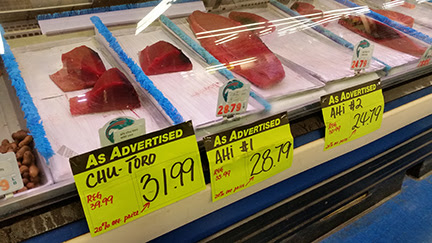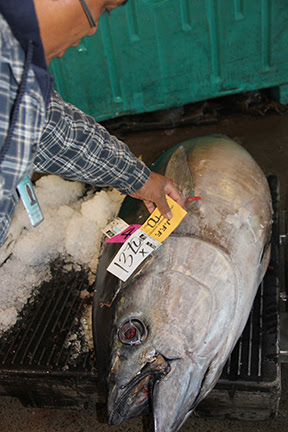Hawaii’s Fishery Reopens, Sashimi Prices Expected to Drop

In a few weeks, after vessels provision and return from fishing, consumers of locally caught sashimi-grade tuna should see a relief from the high prices (reaching nearly $40 per pound for chu-toro, or “ahi with fat”) at retail outlets. Filets comprise about half the weight of a whole fish. Photo credit: Western Pacific Regional Fishery Management Council.
Consumers of locally caught sashimi should see a relief from high prices at retail outlets in Hawaiʻi in the coming weeks, as fishing vessels return with their new catch.
The Western Pacific Regional Fishery Management Council reports that prices have been at nearly $40 per pound for locally caught chu-toro or “ahi with fat” as Hawaiʻi longline vessels complied with a fisheries closure for more than two months.
Since Aug. 5th, the 145 active vessels in the Hawaiʻi longline fleet have been prohibited from catching bigeye tuna in the Western and Central Pacific Ocean after reaching a 2015 limit of 3,500 metric tons.

With limited supply during the closure, prices for bigeye tuna (`ahi) skyrocketed at the Honolulu fish auction. At $13.70 a pound, this 214-pounder was worth nearly $3,000 off the boat. Photo credit: Western Pacific Regional Fishery Management Council.
This week, the National Marine Fisheries Service announced through the Federal Register that the Commonwealth of the Northern Mariana Islands can allocate up to 1,000 metric tons of the region’s catch limit to the US and Hawaiʻi.
The news was especially welcomed for approximately three dozen Hawaii longline vessels that are larger than 24 meters in length. The WPRFMC notes that these larger vessels have been banned from fishing not only in the Western and Central Pacific Ocean, but also in the Eastern Pacific Ocean since Aug. 12, 2015.
According to the international agreement, the US longline fleet has a quota of 500 mt in the region, after which US longline vessels less than 24 meters in length only can operate in those waters.
“The US longline fleet had not increased its effort,” said Kitty Simonds, executive director of the Western Pacific Fishery Management Council in a press release statement, “but it experienced a bumper crop of bigeye, apparently as a result of the El Nino weather.” Simonds said the majority of the bigeye tuna is caught in the equatorial Pacific, far from the Hawaiʻi fishing grounds, and noted that no other country has reached its quota.
Simonds called the quotas “arbitrary,” and said, “The struggling vessels and small businesses they support accumulated millions of dollars in debt each month, causing untold anxiety for our local fishing community and consumers.”
“The Hawaiʻi fishery lands only 1.5% of the bigeye tuna caught in the Pacific Ocean,” Simonds added and continued saying the fishery was being “unfairly penalized for a problem it did not create.”
Representatives with WPFMC called the Hawaiʻi longline fishery unique saying fish are packed in ice and brought fresh to the dock primarily for Hawaiʻi consumption with only 3% being exported.
The value of the fish landed by the Hawaiʻi fleet is estimated to be around $100 million, resulting in the port of Honolulu consistently ranking among the nation’s top 10 ports in landed value, according to the NMFS Fisheries of the United States annual reports.
“The US government must commit to protect the Hawaiʻi longline fishery,” Simonds said. “The alternative is US dependence on foreign imports and the irrevocable loss of Hawaiʻi’s iconic fishery.”










